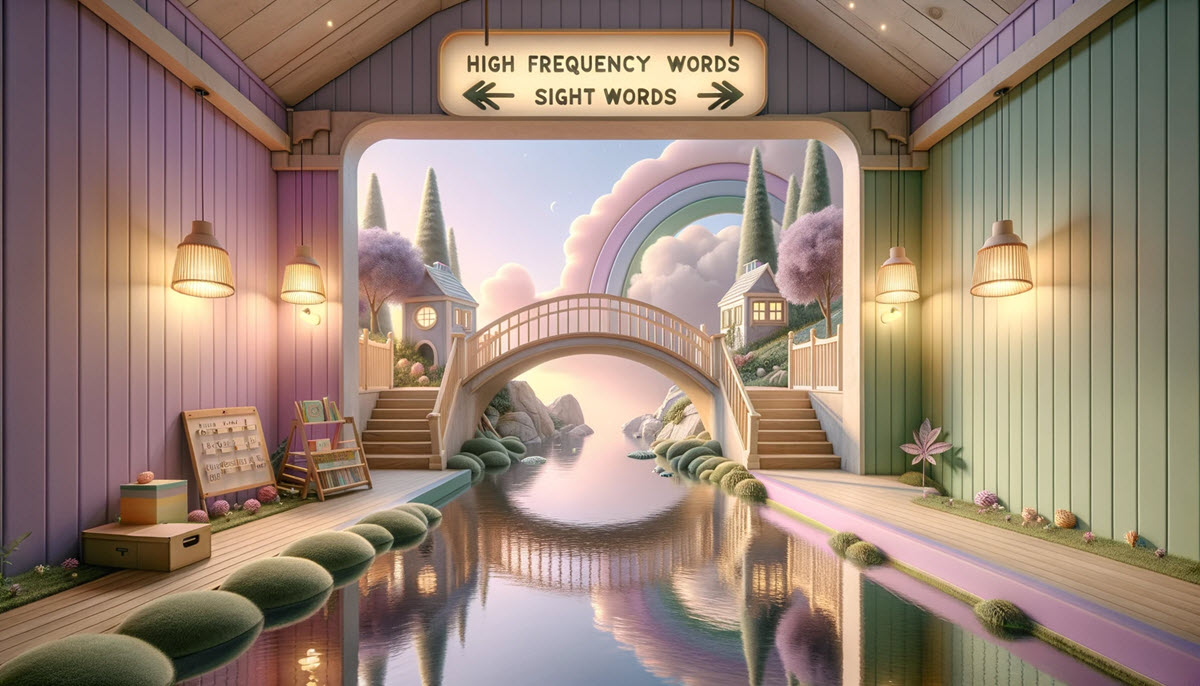High Frequency Words vs Sight Words in Early Reading: Unlocking the Puzzle
Ah, the tender journey of watching your little one morph from babbling toddler to a curious preschooler, keen on exploring the world of letters and words.
It’s a captivating transition, dotted with a blend of exhilaration and gentle frustrations.
As you sit down together for a cozy reading session, you can’t help but marvel at how some words effortlessly roll off their tongue, while others pose a stubborn challenge.
This nuanced dance between the known and the unknown is where the magic of early literacy begins to unfold.

Now, you might have stumbled upon terms like high frequency words and sight words in your quest to bolster your child’s reading prowess. Though they sound technical, they harbor a simple essence crucial to your child’s budding literacy.
High frequency words are those common words that appear often in texts, while sight words are those that your child can recognize instantly, without decoding.
Understanding the interplay between high frequency words and sight words can be a linchpin in nurturing a smooth reading journey for your young one.
As you delve deeper into this article, you’ll unravel the subtle yet significant differences between high frequency words vs sight words, and why mastering them could be your child’s stepping stone to a rich world of literacy.
Along the way, you’ll also discover practical, enjoyable strategies to make these words stick, infusing a dose of fun in this essential learning endeavor.
The pathway to fluent reading is laden with both familiar tunes and new rhythms, and together, we’ll explore how to harmonize them for a melodious learning experience.
Understanding the Basics
High Frequency Words: The Common Companions
High frequency words are like the friendly neighbors we encounter often in our daily walks through the neighborhood of reading. They are the common words that pop up frequently in the texts your child will read.
Examples include simple words like ‘the’, ‘is’, ‘and’, among others.
Two well-known lists that categorize these words are the Fry’s and Dolch lists. These lists compile words based on how often they appear in texts, making it easier to know which words your child will likely see over and over again.
By becoming familiar with high frequency words, your young reader can start to read more fluently and confidently, making their reading journey less bumpy and more enjoyable.
Sight Words: The Speedy Recognizers
On the other hand, sight words are the words your child can recognize instantly, without having to sound them out.
Words like ‘you’, ‘I’, and ‘are’ fall into this category.
The beauty of sight words is that they help to keep the reading flow going.
Imagine having to pause and decode every single word while reading – it could be quite the hiccup in the smooth rhythm of reading! Sight words help to reduce these pauses, making reading a more fluid and delightful activity for your child.
Structured Guidance: Your Compass in Early Literacy
Embarking on this early literacy voyage might feel overwhelming, but fret not!
A structured program can be a guiding star for parents. Our review of the Children Learning Reading Program sheds light on a method that can help you navigate through the basics of high frequency and sight words, ensuring a solid foundation for your child’s reading skills.
Now that we’ve skimmed the surface of high frequency and sight words, let’s dive a bit deeper to unearth the goldmine they hold in enriching your child’s early literacy.
These aren’t just mere words on a page, but keys to unlocking a realm filled with endless stories, ideas, and knowledge.
The understanding and application of these words are like the threads that weave the fabric of effortless reading.
By exploring the dynamics between high frequency words and sight words, and how they can be seamlessly integrated into daily reading activities, you’re not just teaching your child to read—you’re opening doors to a whole new world of exploration and imagination.
In the following sections, we’ll delve into the interplay between these types of words, and share some fun, practical strategies to make them a natural part of your child’s reading adventure.
The Interplay
A Harmonious Dance: High Frequency and Sight Words
Imagine a delightful dance duo, where each dancer brings a unique flair yet moves in sync to create a beautiful performance. Similarly, high frequency words and sight words, each with their distinct roles, dance together to create a fluid reading experience for your child.
High frequency words are the steady rhythm that maintains the pace, ensuring the dance flows smoothly across the reading floor. They are the common words that provide a predictable pattern, making it easier for your child to follow along.
On the flip side, sight words are the spontaneous twirls and spins that add excitement to the dance. They are the words that your child can swiftly recognize, adding a touch of ease and confidence as they read through sentences.
Together, they create a harmonious rhythm that makes reading a delightful dance rather than a stumbling chore.
Balanced Steps: The Essence of Fluent Reading
A balanced approach is like having the right mix of rhythm and flair in our dance analogy.
It’s essential to have a mix of both high frequency and sight words to keep the reading journey engaging and progressive.
For instance, when your child comes across a storybook, they’ll encounter high frequency words that provide a familiar rhythm, making it easier to follow the story. Sprinkled in are sight words that they can quickly recognize, adding a sense of accomplishment and keeping their interest piqued.
Imagine a simple sentence like, “The cat sat on the mat.” In this sentence, ‘the’ and ‘on’ are high frequency words while ‘cat’, ‘sat’, and ‘mat’ can be sight words that your child recognizes at a glance. This blend helps your child to read the sentence smoothly, nurturing a sense of achievement and motivating them to read more.
Now that we’ve explored the elegant dance between high frequency and sight words, it’s time to step onto the dance floor and put these insights into action.
The following section is packed with practical strategies to help you, the guiding star in your child’s literacy journey, make teaching these words a fun and fruitful endeavor. From playful games to creative activities, you’ll discover a treasure trove of ideas to make learning high frequency and sight words an enjoyable adventure.
So, let’s transition from understanding to application, and make every reading session a stepping stone towards a lifelong love for reading.
Practical Strategies for Parents
Making Friends with High Frequency Words
Teaching high frequency words can be a joyful expedition, filled with discovery and fun. Here are a few tips and activities to make this learning journey delightful:
- Flashcards Fun: Create colorful flashcards with high frequency words. Make it a game by timing how fast your child can go through them, and celebrate improvement with little rewards.
- Word Hunt: Turn reading into a treasure hunt by having your child spot and highlight high frequency words in a text.
- Sentence Crafting: Encourage your child to create sentences using high frequency words, which helps in understanding the usage and context.
Sight Words: The Quick Recognizers
Introducing sight words can be like opening tiny windows to a big, beautiful world of reading. Here are some playful ways to teach sight words:
- Word Bingo: Create a bingo game with sight words, and enjoy a fun-filled learning session.
- Sight Word Songs: Set sight words to familiar tunes and sing along together. Music can make learning sight words a more memorable and enjoyable experience.
- Interactive Apps: Utilize interactive educational apps that are designed to make learning sight words engaging and interactive.
It’s crucial to choose words that are age-appropriate to keep the learning process enjoyable and stress-free. For some guidance on selecting the right words for your little one, check out our list of words for kindergarten to learn.
Remember, every child’s learning pace is unique, and what matters most is the joy and curiosity that comes with every new word learned.
As you weave these practical strategies into your daily reading sessions, you’re not just teaching words; you’re laying bricks to build a sturdy foundation of a rich vocabulary and reading fluency.
With every new word, your child steps closer to a broader understanding and a smoother reading experience.
It’s a progressive journey where every day holds the promise of new words, new sentences, and new stories to explore.
The tips shared are stepping stones that will guide you and your child towards a fulfilling literacy journey, making the process of learning high frequency and sight words a cherished part of your daily routine.
Monitoring Progress and Adapting Strategies
Keeping Track: Tools and Techniques
Monitoring your child’s progress is like having a friendly checkpoint in their literacy journey. It helps you understand how well they are grasping high frequency and sight words.
Here are some tools and techniques to make tracking a breeze:
- Progress Charts: Create a colorful progress chart where your child can place a sticker next to the words they’ve mastered. It visualizes learning in a fun, tangible way.
- Flashcard Reviews: Regularly review flashcards to gauge retention and identify words that might need a bit more attention.
- Reading Logs: Maintain a reading log to note down the words your child has learned and any observations about their reading journey.
Adapt and Celebrate: Navigating the Evolving Journey
Every child’s learning pathway is unique and may require some tailoring along the way. If a strategy isn’t working, don’t hesitate to tweak it or try something new.
Here’s how to adapt and celebrate the milestones:
- Adapt Strategies: If a particular method isn’t resonating, try a new one. There’s a spectrum of strategies out there; it’s about finding what clicks for your child.
- Celebrate Milestones: Celebrate the small wins, be it mastering a new word or reading a sentence smoothly. These celebrations fuel motivation and make learning a joyous endeavor.
- Encourage Daily Reading: Make reading a daily habit. It’s a natural way to reinforce learning and discover new words together.
Understanding the words on a page is a significant stride, but grasping the meaning behind those words is the ultimate goal. It’s crucial that your child not only recognizes words but also comprehends the stories they weave together.
Dive deeper into this aspect by exploring our guide on how to help students with reading comprehension. This comprehension is the bridge that takes your child from merely reading words to truly enjoying the magic of stories.
The beauty of this journey is in its flexibility and the joy of discovery it brings to both you and your child. As you monitor progress, adapt strategies, and celebrate the little victories, you’re nurturing a blossoming reader, ready to explore the endless wonders that words can unfold.
It’s a collaborative dance of learning, where each step, each word, brings your child closer to a world rich with imagination and knowledge.
Conclusion
And here we are, at the end of our enlightening voyage through the realms of high frequency and sight words.
We’ve unpacked the essence of these terms, explored their interplay, and delved into fun, practical strategies to make them a lively part of your child’s reading adventure.
As you continue to guide your child through this beautiful labyrinth of literacy, remember, the journey is as rewarding as the destination. Each word your child masters is a sparkling gem added to their treasure trove of knowledge.
So, embrace this precious journey with enthusiasm and curiosity, for the world of words is vast, and the exploration is boundless.
Your companionship on this literacy adventure will not only empower your child but also create a tapestry of cherished memories filled with laughter, learning, and love.

Natalie is a full-time blogger and former elementary school teacher who specializes in helping parents teach their kids to read. With a qualification in Early Childhood Education, over 7 years of experience in education, and a passion for literacy, Natalie provides practical tips, activities, and resources for parents looking to support their child’s learning-to-read journey. She is the proud mom of two young readers and loves sharing her knowledge and experience with other parents. Natalie enjoys spending time with her family, reading, and exploring the great outdoors when she’s not blogging.


